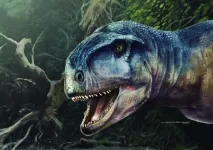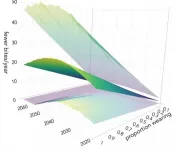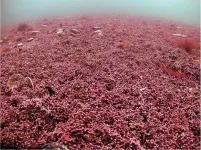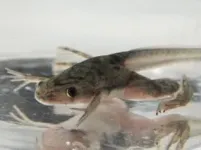The 'one who causes fear' - new meat-eating predator discovered
Ruling in the Late Cretaceous, Llukalkan aliocranianus could be as long as an elephant, had extremely powerful bites, very sharp teeth, and huge claws in their feet
2021-03-31
(Press-News.org) Research published today in the peer-reviewed Journal of Vertebrate Paleontology describes a newly discovered species of dinosaur - named the 'one who causes fear', or Llukalkan aliocranianus.
Around 80 million years ago as tyrannosaurs ruled the Northern Hemisphere, this lookalike was one of 10 currently known species of abelisaurids flourishing in the southern continents.
A fearsome killer, Llukalkan was "likely among the top predators" throughout Patagonia, now in Argentina, during the Late Cretaceous due to its formidable size (up to five meters long), extremely powerful bite, very sharp teeth, huge claws in their feet and their keen sense of smell.
It had a strange short skull with rough bones, so in life its head had bulges and prominences like some current reptiles such as the Gila monster or some iguanas. Its hearing was also different to other abelisaurids. The make-up of its skull suggests this was better than most of the other abelisaurids and similar to that of modern-day crocodiles.
Its full name comes from the native Mapuche for 'one who causes fear' - Llukalkan, and the Latin for 'different skull' - aliocranianus.
It lived in the same small area and period of time as another species of furileusaurian (stiff-backed lizard) abelisaurid - Viavenator exxoni - just a few million years before the end of the age of dinosaurs.
Fossil remains of Llukalkan and Viavenator were found just 700m apart in the Bajo de la Carpa Formation, near the same famous fossil site at La Invernada, in Argentina.
"This is a particularly important discovery because it suggests that the diversity and abundance of abelisaurids were remarkable, not only across Patagonia, but also in more local areas during the dinosaurs' twilight period", says lead author Dr Federico Gianechini, a paleontologist at the National University of San Luis, Argentina.
Abelisauridae were a striking family of theropod dinosaurs averaging five to nine meters long that prowled mainly in Patagonia and other areas of the ancient southern subcontinent Gondwana - recognised today as Africa, India, Antarctica, Australia, and South America. To date, almost 10 species of this fearsome predator have been unearthed across Patagonia. While abelisaurids resembled T-Rex in general appearance with tiny stubby arms, they had unusually short, deep skulls which often bore crests, bumps, and horns, and were unique.
Moving upright on their hind limbs with huge claws that they may have used to stab their prey, Llukalkan had extremely powerful bites and very sharp teeth with which to tear down their prey while moving fast thanks to their powerful hind legs.
The fossilised remains of Llukalkan include a superbly preserved and uncrushed braincase. This new species is similar in many respects to Viavenator, except that it is smaller, the holes in the skull through which the veins pass are larger and more widely separated from the supraoccipital crest (one of the bones that forms the braincase), among other differences. But the new dinosaur's most distinctive feature is a small posterior air-filled sinus in the middle ear zone that has not been seen in any other abelisaurid found so far.
It means that Llukalkan likely heard differently to other abelisaurids - most probably better and similar to that of a modern day crocodile explains co-author Dr Ariel Mendez from the Patagonian Institute of Geology and Palaeontology, Argentina.
"This finding implies a different hearing adaptation from other abelisaurids, and likely a keener sense of hearing", says Dr Mendez.
However it may have lived, the fossil evidence of Llukalkan's adaptations suggests that abelisaurids were flourishing right before the dinosaurs went extinct.
"These dinosaurs were still trying out new evolutionary pathways and rapidly diversifying right before they died out completely," adds Mendez.
Despite their significant finding there is still a lot to discover. "This discovery also suggests that there are likely more abelisaurid out there that we just haven't found yet, so we will be looking for other new species and a better understanding of the relationship among furilesaurs," says Gianechini.
INFORMATION:
[Attachments] See images for this press release:

ELSE PRESS RELEASES FROM THIS DATE:
2021-03-31
Early treatment with anti-VEGF injections slowed diabetic retinopathy in a clinical study from the DRCR Retina Network (DRCR.net). However, two years into the four-year study its effect on vision was similar to standard treatment, which usually begins at the onset of late disease. The intermediate findings published today in the JAMA Ophthalmology. The study was supported by the National Eye Institute (NEI), a part of the National Institutes of Health.
"While it is possible that preventive injections of anti-VEGF drugs may help protect vision in the longer-term, ...
2021-03-31
A new mathematical model suggests that the easing of lockdown must be accompanied by wider and more effective use of control measures such as facemasks even with vaccination, in order to suppress COVID-19 more quickly and reduce the likelihood of another lockdown.
The model, developed by scientists at the Universities of Cambridge and Liverpool, is published today in the Journal of the Royal Society Interface. It uses mathematical equations to provide general insights about how COVID-19 will spread under different potential control scenarios.
Control measures involving facemasks, handwashing and short-scale (1-2 metre) social distancing can all limit the number of virus particles being spread between people. These are termed ...
2021-03-31
With shark bites increasing in countries like Australia - scientists say the use of personal electronic deterrents is an effective way to prevent future deaths and injuries which could save the lives of up to 1063 Australians along the coastline over the next 50 years.
The research, published in scientific journal Royal Society Open Science, shows that while shark bites are rare events, strategies to reduce shark-bite risk are also valuable because they can severely affect victims and their support groups - with one third of victims experiencing post-traumatic stress ...
2021-03-31
Heart attacks in young adults are twice as likely to be fatal in those with inflammatory conditions like psoriasis, lupus or rheumatoid arthritis. That's the finding of a study published today in the European Journal of Preventive Cardiology, a journal of the European Society of Cardiology (ESC).1
At least 2% of people in Europe and worldwide have systemic inflammatory diseases, which often affect multiple organ systems. Many of these systemic inflammatory diseases are driven by autoimmunity, meaning the body's immune system attacks itself. Psoriasis is the most common and causes red, itchy, scaly patches on the skin, and can also cause inflammation in the joints. Rheumatoid arthritis leads to inflammation in joints of the hands and feet and in other organ systems. In systemic ...
2021-03-31
Red algae that grow in Cornwall's Fal Estuary are genetically unique, new research shows.
University of Exeter scientists studied the population genetics of Phymatolithon calcareum, a coralline red algal species that forms maerl beds in shallow coastal seas from Portugal to Norway.
Large maerl beds fulfil a similar role to tropical coral reefs, providing habitats and vital shelter for hundreds or even thousands of fish and invertebrates. These algae also play an important role in storing carbon.
The findings reveal genetic differences are "structured geographically", with slight variations between populations sampled from across this large geographic area.
However, maerl ...
2021-03-31
Human disturbance in urban environments makes some squirrels fail, but others perform better in novel problem-solving.
Unlike natural environments, urban areas have artificial buildings, traffics, less greenery and, most prominently, more humans. Despite these seemingly 'harsh' or stressful characteristics, some wildlife like the Eurasian red squirrel have chosen to settle down in urban environments, and they thrive. Urban wildlife often show higher behavioral flexibility and increased ability to solve novel problems, and thus can exploit new resources. However, which characteristics of urban environments influence animals' performance, and their relative importance, have remained ...
2021-03-31
Scientists have discovered a new genetic disease, which causes some children's brains to develop abnormally, resulting in delayed intellectual development and often early onset cataracts.
The majority of patients with the condition, which is so new it doesn't have a name yet, were also microcephalic, a birth defect where a baby's head is smaller than expected when compared to babies of the same sex and age.
Researchers from the universities of Portsmouth and Southampton found that changes in a gene called coat protein complex 1 (COPB1) caused this rare genetic disease.
Now the variant has been identified, it will help clinicians come up with targeted interventions to help patients and their families, also opening the door to screening and prenatal ...
2021-03-31
A new study examining how people with severe and profound intellectual disabilities resist activities while in care recommends that institutions improve training to help carers better understand non-verbal cues, as well as offer greater flexibility to allow individual preferences to take priority over institutional schedules.
The research, published in the journal Sociology of Health and Illness, investigated how people with limited language ability expressed their wishes and preferences, and how their support workers responded. It was carried out at a residential home and a day care centre in the UK.
The study, by Dr Clare Nicholson of St Mary's University, Twickenham, and Dr Mick ...
2021-03-31
In the run up to hibernation, grizzly bears go on a colossal binge, consuming as many calories as possible to get them through the long winter. Yet, little was known about how much energy the massive mammals use as they shamble around their rugged territories. 'Moving across the landscape in search of food can be a huge energetic expense for some animals', Carnahan says. Fortunately, the Washington State University Bear Research, Education and Conservation Center (WSU BREC), where Carnahan is based, is home to 11 bears, including four that formerly lived in Yellowstone National Park, so he and Charles Robbins (also at WSU BREC) decided to measure the animals' metabolic rates as they sauntered on the flat, and up and down gradients to find out how much ...
2021-03-31
New research published in Anaesthesia (a journal of the Association of Anaesthetists) challenges the guidance that special aerosol precautions are only needed when using oxygen therapies for COVID-19 patients, and raises concerns about safety of staff and patients on hospital wards, if they are not protected from infectious aerosols.
The study set out to examine whether oxygen therapies used for patients with severe COVID-19 produce large amounts of small respiratory particles called aerosols, which can transmit virus and can evade routine precautions used on hospital wards. ...
LAST 30 PRESS RELEASES:
[Press-News.org] The 'one who causes fear' - new meat-eating predator discovered
Ruling in the Late Cretaceous, Llukalkan aliocranianus could be as long as an elephant, had extremely powerful bites, very sharp teeth, and huge claws in their feet



